Cloud computing is everywhere and anywhere Internet-related business is done. Google and Amazon are just as prevalent in the modern discussion of Internet powerhouses.
How do they stack up when it comes to their cloud computing offerings? Let’s have a look at Google cloud vs AWS.
Computing Resources
While Amazon’s service, called AWS, and Google’s service both have powerful computing resources, one primary difference is Google’s adaptability, which is slightly better than Amazon’s.
They also use SSDs that make the connections fast. More on this later.
Google Cloud gives you the option of customizing how much CPU power and RAM is used for different processes. In effect, you get to build your own machine in the cloud, and tell it how to allocate its resources.

It’s appropriately named a “custom machine.” While AWS can do something similar, Google Cloud’s presentation is more straightforward.
SSD Storage Cost
A solid state drive (SSD) cuts down on processing time significantly. Its smaller size has inherent benefits as well.
But because all of that is in the cloud in AWS and Google Cloud, the main concern for those of us down here on the “ground” is the cost. Here, AWS has the advantage.
Here’s why:
It is significantly cheaper than Google Cloud, at $0.10 per gigabyte per month versus Google Cloud’s $0.17 per gigabyte per month. This is a significant difference.
If you opt for Google Cloud, you do get other benefits such as the flexibility of the computing resources, but it will come at a cost when you have to pay more for your SSD.
Next, let us look how region-based storage differs between Google Cloud and AWS.
Multi-Region Object Storage Costs
In the pricing war, Google Cloud strikes back with a less expensive Hot Multi-Region pricing package.

It comes in at merely $0.026 per gigabyte per month, and includes transfer, whereas AWS charges significantly more at $0.046 per gigabyte per month, and the transfer is an additional $0.01.
Here’s the bottomline:
If these storage services are important to you, you may have to end up shelling out more cash for AWS than you would for Google Cloud.
Even with these differences, are there things that both platforms have in common? Read on to find out.
Some Things They Have in Common
AWS and Google Cloud are certainly not apples and oranges; there are some points of commonality, though. Naturally, each feature has a different name in each platform, but they do the same things.
For instance, for the various network products, the load balancing is called “Cloud Load Balancing” under Google Cloud and “Elastic Load Balancing” under AWS. This difference is fairly easy to distinguish.
Now:
When it comes to the network interconnection features, the names are significantly more different, “Cloud Interconnect” for Google Cloud and “AWS Direct Connect” for AWS.
Because of the varying nomenclature, a thorough reading of each feature’s description will be an essential step in the choosing process.
Conclusion
All-in-all, Google Cloud and AWS both have their advantages. One thing they both have is a ton of resources that almost any business can benefit from. A thorough examination of each one’s pros and cons can be done after you ascertain what you will need.
There are some features that may make one or the other more appealing, but if those features don’t necessarily give your business an advantage, you may want to eliminate them from your list of considerations.
But making a thorough list of necessary attributes will make the decision in Google Cloud vs AWS that much more simple.





